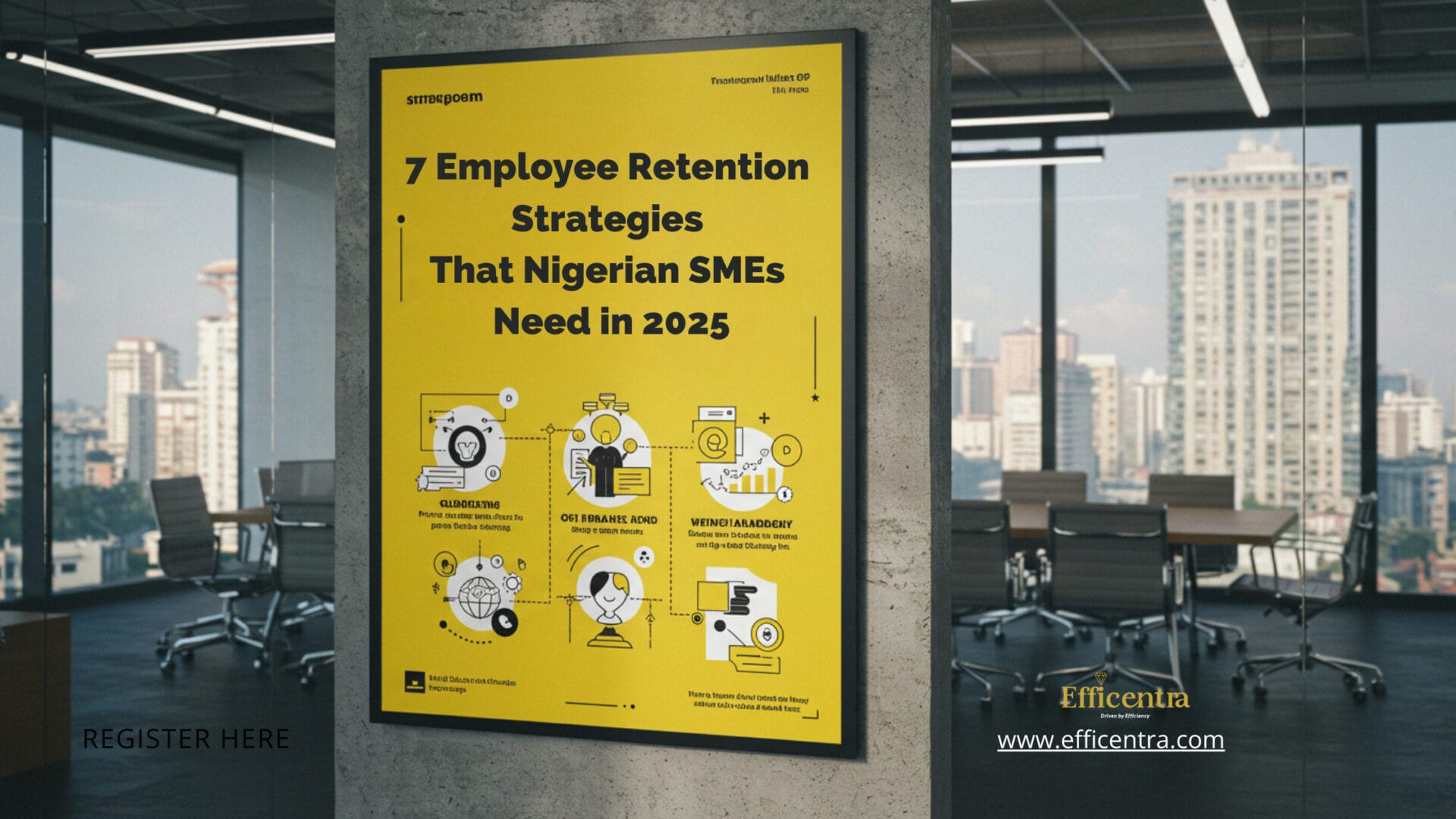7 Employee Retention Strategies for Nigerian SMEs
What is your companies employee retention strategy? Discover why Nigerian SMEs face 40% higher employee turnover and 7 proven employee retnention strategies to build retention-focused workplace culture. Implementation guide included.
Nigerian small and medium enterprises face an employee retention crisis that’s quietly undermining growth. While many business owners focus on external challenges like foreign exchange rates and regulatory changes, internal workforce instability often causes more damage to the bottom line.
The reality is stark: companies with poor workplace culture experience 40% higher SME employee turnover than those with strong cultures. For a 30-employee company, this translates to replacing 12 people annually instead of 7, a difference that costs millions in recruitment, training, and lost productivity.
The 7 strategies in this guide can reduce your turnover by up to 60% within 12 months.
Quick Summary: 7 Employee Retention Strategies
- Create Clear Growth Pathways – Define career progression routes
- Establish Communication Rhythms – Regular feedback and updates
- Design Meaningful Recognition – Acknowledge different contributions
- Invest in Skills Development – Allocate 2-3% revenue to training
- Improve Work-Life Balance – Address burnout and stress factors
- Review Compensation Competitively – Ensure fair market-rate pay
- Monitor Culture Health – Track retention metrics quarterly
The Real Cost of Employee Turnover in Nigerian SMEs
Understanding the true cost of staff turnover helps SME leaders make informed decisions about retention investments.
Consider a typical scenario: replacing a mid-level employee in Lagos costs approximately ₦800,000 to ₦1.2 million when you factor in:
- Recruitment advertising and agency fees
- Interview time and management hours
- Training and onboarding costs
- Productivity loss during transition period
- Knowledge and relationship gaps
For many SMEs, this represents 15-20% of the employee’s annual salary money that could otherwise fund expansion, technology upgrades, or market development.
What Drives Employees Away (Beyond Salary)
Research across workplaces reveal five primary reasons employees leave SMEs:
1. Lack of Growth Visibility
Employees can’t see a future path within the organization. Unlike large corporations with defined career ladders, many SMEs operate with flat structures that offer limited advancement opportunities.
Impact on retention: 67% of Nigerian professionals cite career development as a key factor in job decisions.
2. Poor Communication from Leadership
Decisions appear arbitrary, feedback is infrequent, and employees feel disconnected from company direction and strategy.
Impact on retention: Poor communication from management is the #2 reason Nigerian employees leave SMEs.
3. Inadequate Recognition Systems
Good performance goes unnoticed while poor performance is quickly addressed. This imbalance creates demotivation among high performers.
Impact on retention: Unrecognized employees are 3x more likely to job search actively.
4. Work-Life Balance Issues
SMEs often operate with lean teams, leading to employee burnout and stress that eventually drives departures.
Impact on retention: 45% of Nigerian professionals report work-life balance as a primary job satisfaction factor.
5. Limited Professional Development
Training budgets are minimal, and employees feel their skills aren’t growing, making them less competitive in the job market.
Impact on retention: Companies investing in employee development see 34% higher retention rates.
7 Staff Retention Strategies That Work for Nigerian SMEs
Strategy 1: Create Clear Growth Pathways
Even small companies can offer advancement through career development approaches. Define skill-based progression rather than just title promotions.
Implementation for employee retention:
- Document role progression maps showing required skills
- Set timeline expectations for advancement (12-18 months typical)
- Create advancement criteria for each position
- Offer cross-functional training opportunities
Strategy 2: Establish Regular Communication Rhythms
Weekly team updates: Share company performance, upcoming projects, and strategic decisions affecting the team.
Monthly one-on-ones: 30-minute individual meetings to discuss performance, challenges, and career goals.
Quarterly strategy sessions: Include employees in planning discussions and gather input on operational improvements.
Strategy 3: Design Recognition That Matters
Beyond monetary rewards, implement employee recognition systems that acknowledge different types of contributions:
- Performance recognition: Monthly awards for exceptional results
- Innovation recognition: Acknowledge employees who suggest process improvements
- Value recognition: Highlight behaviors that exemplify company values
- Peer recognition: Allow team members to nominate colleagues for recognition
Strategy 4: Invest in Skills Development
Allocate 2-3% of annual revenue to employee development. This investment typically returns 200-300% through improved performance and retention.
Development options include:
- Industry conference attendance
- Online certification programs
- Skills workshops and seminars
- Cross-functional training within the company
Strategy 5: Improve Work-Life Balance
Address burnout and stress that drives SME employee turnover by implementing balance-focused policies:
Work-life balance initiatives:
- Flexible working hours where operationally possible
- Remote work options for suitable roles
- Mental health and wellness programs
- Reasonable workload distribution
- Mandatory time-off policies
Strategy 6: Competitive Compensation Review
While not always the primary factor, ensuring fair compensation prevents staff turnover:
Compensation strategy:
- Annual market salary benchmarking
- Performance-based bonus structures
- Non-monetary benefits (health insurance, transportation)
- Transparent pay scale communication
- Regular compensation reviews
Strategy 7: Monitor and Measure Culture Health
Track retention metrics quarterly to identify improvement areas:
- Voluntary turnover rate by department
- Exit interview themes and patterns
- Employee satisfaction scores
- Internal promotion percentage
The Business Case for Workplace Culture Nigeria Investment
Companies that prioritize staff retention strategies see measurable improvements:
- Productivity increases of 15-25% within 12 months
- Customer satisfaction improvements as engaged employees provide better service
- Reduced recruitment costs through lower turnover
- Enhanced reputation making it easier to attract quality candidates
More importantly, strong culture becomes a competitive advantage in talent acquisition, especially as skilled workers become more selective about employers.
Implementation Timeline for SME Employee Retention
Month 1: Assessment and Planning
- Conduct employee surveys to understand current satisfaction levels
- Analyze turnover patterns and exit interview data
- Define company values and desired culture characteristics
- Create communication and recognition frameworks
Month 2: System Implementation
- Launch regular communication rhythms
- Implement employee recognition programs
- Begin career development conversations
- Establish feedback mechanisms
Month 3: Monitoring and Adjustment
- Gather initial feedback on new initiatives
- Adjust systems based on employee input
- Plan longer-term development programs
- Measure early impact on engagement metrics
When to Seek Professional HR Support
Culture transformation becomes complex when dealing with:
- Resistant middle management
- Multiple departments with different needs
- Previous failed attempts at culture change
- Rapid growth requiring scaled solutions
- Integration of new acquisitions or partnerships
Professional HR consulting in Nigeria becomes valuable when internal resources lack the expertise or bandwidth to manage comprehensive culture transformation while maintaining daily operations.
Measuring Employee Retention Success
Track these key indicators to assess culture transformation effectiveness:
Leading Indicators (Month 1-3):
- Employee satisfaction survey scores
- Participation rates in new programs
- Frequency of employee suggestions and feedback
Lagging Indicators (Month 6-12):
- Voluntary turnover reduction
- Internal promotion rates
- Customer satisfaction improvements
- Revenue per employee growth
Long-term Indicators (Year 2+):
- Employer brand reputation
- Quality of job applicants
- Employee referral rates
- Business performance correlation with engagement
The Strategic Advantage of Employee Retention Nigeria
Strong workplace culture isn’t just about employee satisfaction it’s about building a sustainable competitive advantage. Companies with engaged workforces consistently outperform competitors in profitability, customer service, and innovation.
For Nigerian SMEs competing against larger corporations and international companies, culture can be the differentiator that attracts and retains top talent despite resource constraints.
The investment required is modest compared to the cost of ongoing SME employee turnover and disengagement. The question isn’t whether you can afford to build strong culture it’s whether you can afford not to.
7-Step Action Plan for Better Employee Retention
Step 1: Assess current retention challenges using the framework above
Step 2: Calculate your actual turnover costs to understand investment ROI
Step 3: Choose 3-4 retention strategies to implement immediately
Step 4: Set measurement systems to track improvement
Step 5: Train managers on new retention practices
Step 6: Communicate changes clearly to all employees
Step 7: Consider professional support for comprehensive transformation
Next Steps for Better Employee Retention
Ready to implement these employee retention strategies? Start with our proven 7-step approach above, or contact Efficentra for a comprehensive retention assessment tailored to your Nigerian SME.
Related Articles:
- https://efficentra.com/category/leadership-strategy/
- https://efficentra.com/organizational-change-management/

About the Author
Helen Solange Inengite is the Principal Consultant at Efficentra, serving as a strategic partner to Nigerian SMEs in building high-performance teams and driving sustainable growth. With over 16 years in HR and business strategy, she is also a certified happiness coach passionate about employee well-being







